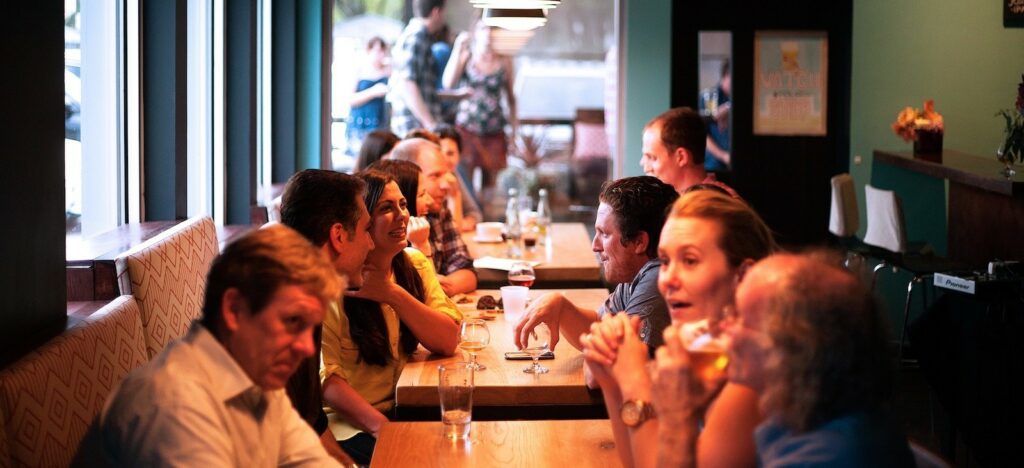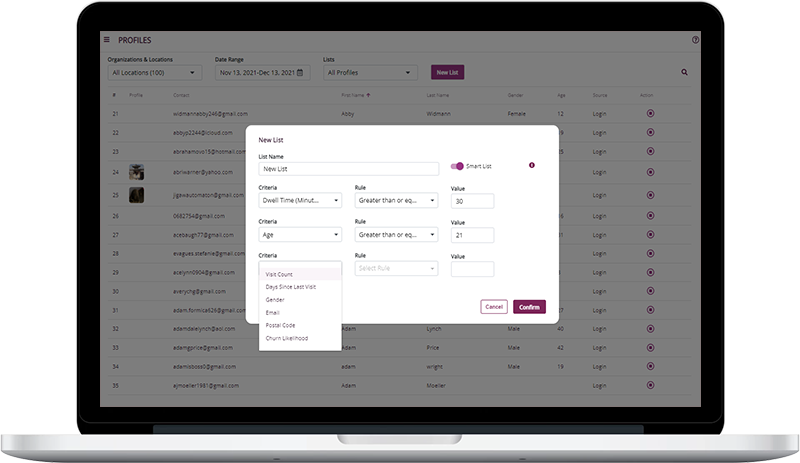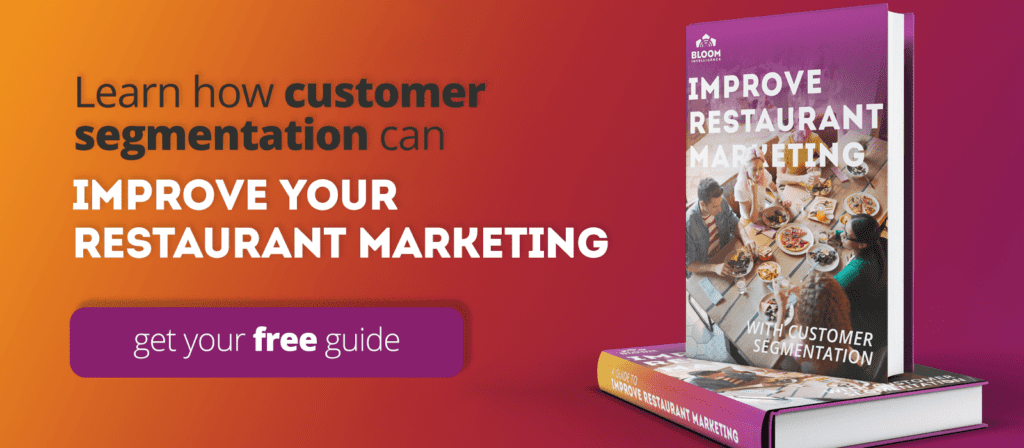In our previous four posts, we discussed what a customer data platform (CDP) is, how to gather guest data, the insights you can discover, how to create effective restaurant marketing campaigns, and how to segment your database for better marketing ROI.
This final post in the series will summarize these things and then discuss how to monitor your marketing campaigns, test them, and optimize them over time.
Accurate marketing attribution for restaurants, or any brick-and-mortar business, has always been a thorn in the side of marketing professionals. However, in today’s competitive environment, it is absolutely necessary.
In fact, adding attribution to your restaurant marketing strategy can improve your results tremendously. According to Gartner, the typical outcome of implementing attribution is a 20-30% gain in media efficiency and corresponding increases in ROI.

Analyzing Guest Behavior Using Your Customer Data Platform
The secret to capturing guest data is to use a captive portal that works through your existing WiFi service. If you’ve already provided free WiFi to your guests, you can turn this into a symbiotic process.
You can also capture guest data by integrating your CDP with your online ordering system, POS, or reservation system.
A captive portal is simply the page that a guest is directed to when logging into your WiFi. There are many things you can do when developing a captive portal. You’ll find several examples here.
You can build guest profiles, onboard guest data onto third-party applications, and automate your marketing campaigns quickly and easily.
Once you begin collecting guest data, you might find some surprises about how your loyal patrons typically behave. Then, based on real data, you can adjust marketing and operations procedures to optimize your business over time.
You will see things like guest dwell times, popular days and times, age and gender distribution, visit repeat rates, postal codes, birthdates, and more.
Then, you create specific guest lists to send targeted marketing messages based on behavior and demographic data. This is known as customer segmentation and can provide a much higher ROI on your marketing efforts.
Customer segmentation and personalization of your marketing messages are crucial in today’s competitive marketplace. Segmentation refers to using customer data to create much more effective email content because it can be tailored for each individual or each customer persona.
Using personalized messaging has been proven to improve open rates and generate more revenue because it allows restaurant marketing professionals to create more relevant content that will more effectively pique the interest of the consumer.
By collecting guest data and grouping those guests into separate lists, marketers can avoid sending out a single mass message in hopes that it resonates well with at least some of the audience.
Instead, they can focus on sending highly targeted messages to each guest segment, increasing open rates and encouraging more engagement.
This can all be automated through your customer data platform. All you have to do is monitor results, test, and optimize over time.
Getting Started: How to Collect Individual Customer Data
To execute an effective personalized restaurant marketing campaign, you’ll need to have comprehensive data about your individual guests.
There are various ways in which to collect the data, but most are either expensive or take a great deal of time and energy. The only efficient way to gather enough comprehensive, verified data to effectively create a personalized campaign is to use a restaurant customer data platform to gather the data from WiFi and your existing third-party applications.
You’ll be able to capture data directly from your guests when they log into your WiFi access point, order online, make an online reservation, or interact with any of your other third-party digital applications.
This will allow you to passively gather the necessary individual guest data required for proper segmentation, reporting, and optimization.
In addition to all of the demographic information, the CDP also tracks the physical behavior of your guests, logging things such as dwell times, repeat visits, coupon & offer redemption, days of the week, and hours of the day they have visited.
With this kind of thorough and reliable data, marketers can begin using it to build powerful, data-driven targeted restaurant marketing campaigns and track them in detail – all the way down to a guest coming back through your door, redeeming an offer, or ordering online.

Using Data to Build Personalized Marketing Messages
According to research from Salesforce, the world’s #1 customer relationship management platform, data targeting and segmenting were used 51% more by overperforming businesses than those who were underperforming.
This makes perfect sense when thinking about today’s consumers. They expect personalized messaging and they quickly sniff out when they’re receiving a simple generic mass-marketing message.
The simplest way to get started creating segmented and personalized campaigns is to make your CDP data filterable. This will allow you to start building segments of specific customers based on their demographics and behavior data.
Customer Segmentation for Marketing Using Your Customer Data Platform
It is important to be able to save these segmented lists so you don’t have to build them each time you want to send out a message.
Some examples of segmented lists might include:
- Women over 30 who visited on Mother’s Day of last year.
- Any guest who has visited more than x times.
- Guests whose average dwell time is under 20 minutes.
- Men below 45 years old who have only visited your establishment once.
- Women/Men who only visit at lunchtime.
As you can imagine, each of these specific audiences would likely engage and respond best to entirely different marketing messages. Being able to segment your guest list allows this to happen.
While building these lists, you’ll need to be brainstorming about how to effectively engage these groups. As you go through this process, ask yourself and your team members these questions:
- What kind of action do I want this guest to take?
- How is the best way to reach this guest?
- What kind of deals or promotions would interest this guest?
- What kind of deals and promotions would this guest NOT be interested in?
- Think of new products or services that might engage this guest?
- What are this guest’s pain points? Why do they need what I offer?
- How can I attract and engage more guests like this?
- What type of imagery/media would engage this guest?
Once you have created your restaurant’s ideal guest segments, then you can launch your campaigns and begin monitoring and testing.
Always Test and Optimize Your Marketing Campaigns
 Now that you have your guest segments properly defined, and you have an idea of the marketing messages and promotions you want to send to them, it’s time to get started.
Now that you have your guest segments properly defined, and you have an idea of the marketing messages and promotions you want to send to them, it’s time to get started.
When you create and send your marketing message to each list, it is vital that you monitor the ROI and attribution of each campaign. (more on this below)
As initial results come in, analyze the results and keep them documented in your platform.
The next time you send a message to each group, you’ll want to make a small change to the message.
You should only make a single change to the message while testing. Send the message and compare its results to the original message.
If the results are not as good as the original, go back to your original message and test a different aspect of the message.
If results are better, keep the change and continue testing and optimizing with other changes over time. This is known as A/B testing.
Also, don’t forget that you’re not just targeting current guests. You should also be seeking out new lookalike prospects online and targeting them in an effective manner using the data you’ve collected.
These prospects will have a higher probability of becoming a new guest, providing a more cost-effective means of acquiring new patrons.
What’s most important to remember is that data from your customer data platform lets you set up a more targeted restaurant marketing campaign. The more you know, the more targeting you can achieve in any future marketing content you send.
This adds value to the guest experience and can quickly improve your engagement rates and subsequent revenue.
Using a customer data platform to collect a large volume of the right data, personalizing your marketing campaigns, testing and optimization have never been easier. You’ll feel confident as you make solid data-driven decisions, drive company growth and build a much larger base of loyal guests.
What is Marketing Attribution?
Marketing attribution is the marketing term used for applying credit to individual marketing tactics and messaging, and attributing ROI to them. When done correctly, it allows marketers to apply more focus on tactics and messaging that are working well, and less focus on those that aren’t.
The main ingredient for effective, proper marketing attribution is accurate, comprehensive guest data.
Traditionally, this type of data was difficult and expensive to acquire. And it was simply a snapshot in time. In other words, if you wanted updated data, you would have to pay for it over and over.
Fortunately, customer data platform technology has eliminated this difficult challenge.
Using a Customer Data Platform for Accurate Guest Data
Using a restaurant customer data platform like Bloom Intelligence, marketers will have the ability to see the most accurate and reliable guest data available today.
As soon as you install the platform, you will begin seeing data updated in real-time. You’ll see things like daily/hourly visitors, repeat visitors, dwell times, popular visit times and so much more. Moreover, you can see this data even if your guests do not log into your WiFi – or if they order online.
If a guest does log into your WiFi or orders online, the platform will create a customer profile for the guest and all of their previous and future data will be added to the profile.
How Does Restaurant Marketing Attribution Work?
Now that you have the guest’s contact information, you can begin marketing to them. And you don’t have to send mass-marketing messages to your entire database. You can segment your database based on their demographics and behavior while at your place of business or when ordering online.
For instance, you can create a marketing campaign for women under 40 who visit your store on Sundays. Or, you can send a targeted message to men between 21 and 30 years old who have a dwell time of over 1 hour. The opportunities are endless.
And since your CDP will recognize when a guest comes back or re-orders online, marketing attribution on these campaigns becomes extremely easy. With Bloom, you’ll be able to see who received a marketing message, who opened it, who came back to your location or ordered online, and whether or not they redeemed any offer that you attached to the message.
This is data that restaurant owners and operators haven’t had access to before. And its cost is pennies on the dollar when comparing to traditional market research solutions.
Let’s take a look at a couple examples of WiFi marketing attribution.
WiFi Marketing Attribution Example 1
In this example, we will assume that you are finding your guest dwell times are decreasing and you want them to increase. You create an email that you will send to your entire database. The email will contain an offer for a free dessert or 50% off an appetizer.
You send out the email and wait for the results.
A few days later, patrons start redeeming the offer in your store or online. With Bloom, you are not simply counting how many guests redeemed the offer. You will be able to see an accurate picture of how many people returned, even if they did not redeem the offer. Plus, you’ll be able to see accurate dwell time measurements.
If the dwell times increase, then you can attribute this to your marketing campaign. You can then make an intelligent, data-driven decision around the ROI of the campaign and decide if you would like to continue, make changes to, or eliminate the campaign.

WiFi Marketing Attribution Example 2
With Bloom, you have the ability to ask your guests their birthday upon logging into WiFi or ordering online. So you and your marketing team decide that you’d like to help increase guest loyalty by executing a “free meal on your birthday” campaign.
You create an email that you will send to anyone in your guest database who has entered their birthday. The email will be sent a few days prior so they can make plans to come to your place of business. The email will also contain a redemption code that can be redeemed when they arrive.
From that moment on, you will be able to see how many people received the offer, how many viewed the offer, how many returned on their birthday, and how many redeemed the item. Over time you can attribute ROI to the campaign and decide whether to keep it running, make changes to it, or eliminate it altogether.
More On Testing and Optimization
You need to make sure that the solution you’re using provides detailed and comprehensive reporting features, and the ability to track testing campaigns.
It can be tempting to use your own intuition to predict what will make people come into your restaurant or visit your store, but it’s vital to understand that customer perceptions, experiences, and likes/dislikes are limitless.
Basing marketing decisions on one person’s “feelings” can be detrimental to your business.
You also need to be able to attribute customer behavior to specific channels and campaigns. For instance, you want to distinguish if a guest came to your location because of an advertisement they saw online, through an email message, or from a radio commercial.
Additionally, you want to know which particular marketing message they responded to, and to which guest segment(s) they belong.
This will allow you to optimize your marketing messages based on accurate, tangible data, and strive for continuous improvement. If you’re not measuring your marketing campaigns and ROI at this level of detail, you will not know for sure if what you are doing is helping or hurting your business.
You want to continuously A/B test your marketing messages. Without testing, you’re always leaving potential revenue on the table. Just make sure that the tools you are using can give you the accurate reports and KPIs required to determine which messages are working better than others.
And always allow plenty of time to give yourself a large enough sample size to confidently determine your winners – the more, the better.
Bloom Intelligence Restaurant Guest Data Platform
Bloom Intelligence gives you the ability to track the results of every campaign you create – all the way down to a guest returning to your place of business, ordering online, and/or redeeming an offer. Bloom’s CDP analytics detect the device of any consumer that walks back into your location that received one of your offers, messages, or surveys.
To learn more about the ways the Bloom Intelligence growth tools can help you improve your restaurant marketing to drive more sales, improve overall guest experience, measure customer sentiment, grow your business, and save you time, call 727-877-8181 to schedule a free demo today or schedule a demo online here.








.svg)